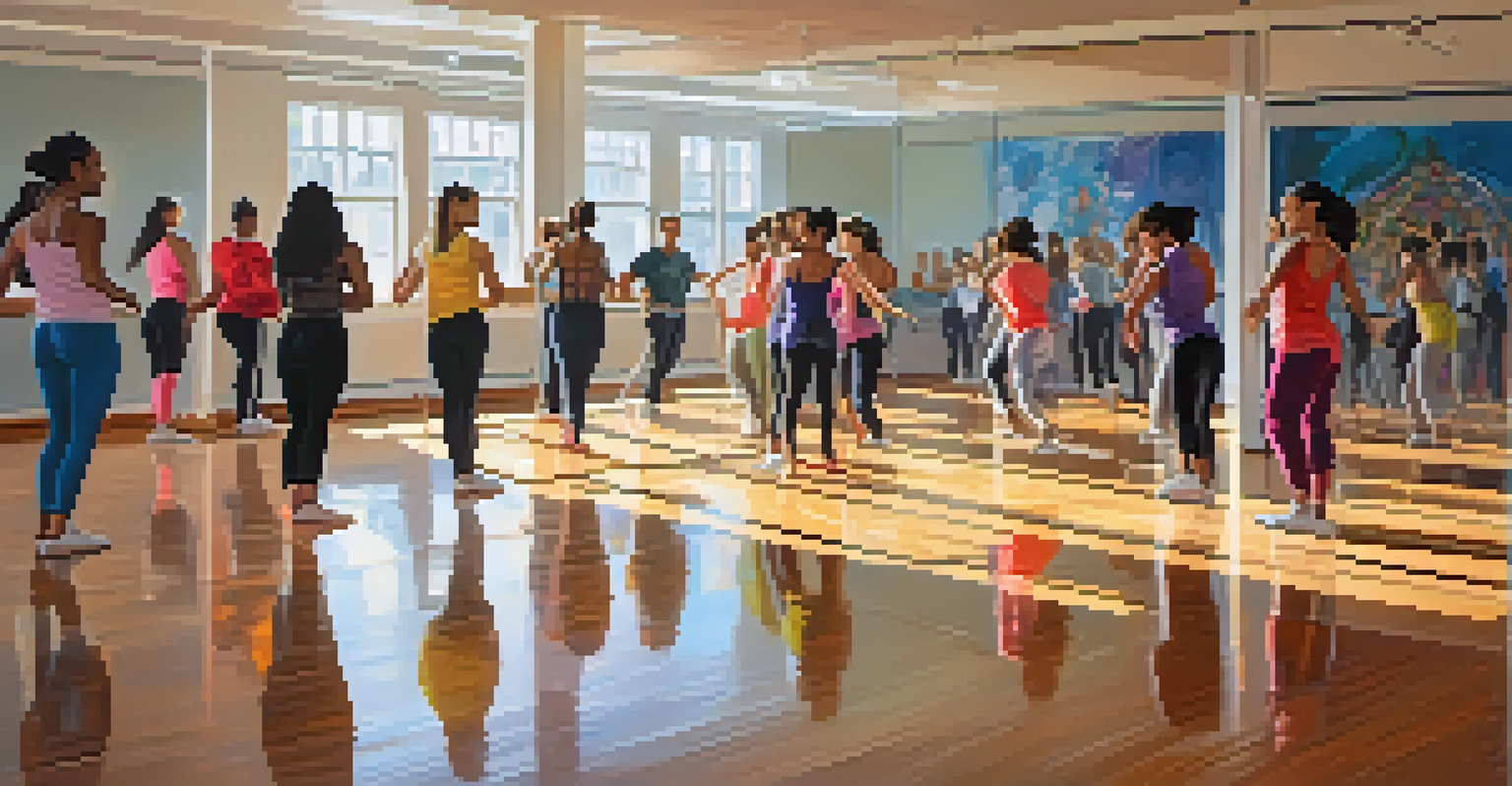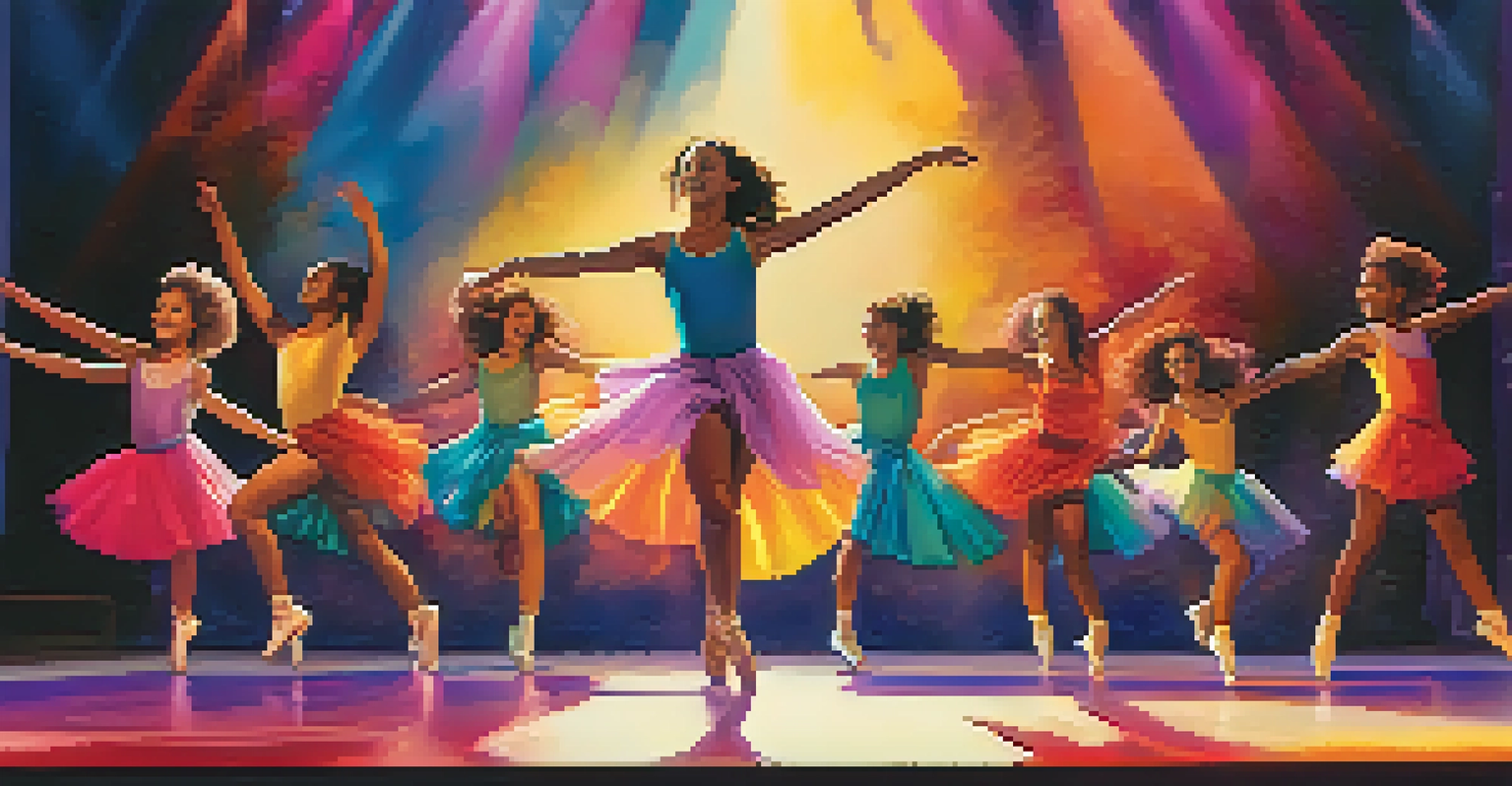Fostering Leadership Skills Through Dance Education Programs

Understanding the Connection Between Dance and Leadership
Dance education is not just about mastering steps; it’s a vibrant platform for developing essential leadership skills. When students engage in dance, they learn to express themselves creatively while also collaborating with others. This combination fosters a sense of responsibility as they work toward common goals, mirroring the dynamics of effective leadership.
Dance is the hidden language of the soul.
In group dance settings, students must communicate and listen actively to one another. This practice translates well into leadership, where clear communication and the ability to consider others’ perspectives are vital. As dancers navigate choreography, they learn to adapt and think on their feet, essential traits for any leader facing unexpected challenges.
Moreover, dance encourages a growth mindset, where failures in performance become opportunities for improvement. This resilience is a cornerstone of strong leadership, enabling individuals to face setbacks with confidence and determination. Thus, the synergy between dance and leadership skills becomes evident through shared experiences and personal growth.
Teamwork: The Heart of Dance and Leadership
One of the most significant aspects of dance is its inherently collaborative nature. Dancers rely on one another to create a cohesive performance, mirroring the teamwork necessary in effective leadership. Each dancer’s contribution is crucial, emphasizing that great leaders recognize and harness the strengths of their team members.

In dance, students learn how to give and receive constructive feedback, a fundamental skill in any leadership role. This process helps build trust and respect among peers, essential for any successful team dynamic. Leaders who value collaboration foster an environment where everyone feels empowered to share ideas and take initiative.
Dance Cultivates Leadership Skills
Engaging in dance education fosters essential leadership skills such as communication, teamwork, and adaptability.
Additionally, practicing choreography can teach students about role delegation. Just as a dance requires a lead and supporting dancers, effective leaders must assign tasks based on team members' strengths and weaknesses. This experience in dance cultivates an appreciation for diverse skill sets, preparing students for future leadership opportunities.
Building Confidence Through Dance Performance
Performing in front of an audience is a powerful way to build confidence, a key trait of effective leaders. Dance education provides numerous opportunities for students to showcase their hard work, helping them overcome performance anxiety and self-doubt. This journey from practice to performance mimics the path leaders take when presenting ideas or leading teams.
The function of leadership is to produce more leaders, not more followers.
As dancers prepare for a show, they learn to set goals and work diligently to achieve them. This goal-oriented mindset is crucial for leadership, as it encourages individuals to envision the bigger picture and strive for success. The sense of accomplishment after a performance can boost self-esteem, reinforcing the belief that they can lead effectively.
Moreover, the supportive environment within dance classes encourages students to celebrate each other's successes. This camaraderie not only builds confidence but also teaches future leaders the importance of uplifting others. Recognizing and appreciating contributions strengthens relationships, an essential part of leadership.
Creativity: A Vital Leadership Skill Nourished by Dance
Dance is an art form that thrives on creativity, and this creativity extends beyond the dance floor into various aspects of life. Leaders often face complex problems that require innovative solutions, and dance education nurtures this skill through improvisation and choreography creation. By encouraging students to express themselves freely, dance helps unlock their creative potential.
In classes, students are often challenged to think outside the box, whether in creating their own dance routines or interpreting existing ones. This practice cultivates a flexible mindset and the ability to approach challenges with fresh perspectives—qualities that are invaluable in leadership. Creative thinking fosters adaptability, enabling leaders to respond effectively to changing circumstances.
Confidence Grows Through Performance
Performing in front of an audience helps build confidence, a crucial trait for effective leaders.
Furthermore, the process of creating and performing dance can teach students to embrace risk-taking. Great leaders are often those who are willing to step outside their comfort zones, and dance provides a safe space to explore new ideas. This willingness to innovate can lead to breakthroughs, both in dance and in leadership.
Emotional Intelligence: Understanding Yourself and Others
Dance education offers unique opportunities for students to develop emotional intelligence, which is crucial for effective leadership. By exploring various movements and expressions, students learn to connect with their emotions and those of others. This heightened awareness enables future leaders to empathize with their team members and respond appropriately to different emotional situations.
In dance, understanding body language and facial expressions is vital for conveying a story or emotion. This sensitivity to nonverbal cues translates into personal interactions, allowing leaders to gauge the mood of their team. Emotional intelligence fosters strong relationships, as it helps leaders connect with their team on a deeper level.
Moreover, dance encourages students to reflect on their feelings and experiences, promoting self-awareness. Leaders who understand their own emotions can manage them effectively, reducing stress and improving decision-making. This introspection, cultivated through dance, lays a strong foundation for emotionally intelligent leadership.
Discipline and Commitment: Keys to Successful Leadership
Dance requires a high level of discipline and commitment, qualities that are equally important in leadership. Students must practice consistently to improve their skills, mirroring the dedication required to lead effectively. This routine instills a sense of accountability, as they learn that success comes from hard work and perseverance.
Through regular rehearsals and performances, students develop a strong work ethic that can be applied to future endeavors. Leaders often face challenges that require unwavering commitment, and the discipline learned in dance prepares students for such situations. This sense of responsibility fosters reliability, a key trait of successful leaders.
Emotional Intelligence in Dance
Dance education enhances emotional intelligence, enabling future leaders to empathize and connect with their teams.
Furthermore, the journey of mastering dance routines teaches students the value of patience and resilience. Mistakes are part of the learning process, and overcoming them builds character. These lessons in discipline and commitment are essential for anyone aspiring to lead, as they lay the groundwork for long-term success.
The Lasting Impact of Dance Education on Future Leaders
The skills developed through dance education extend far beyond the dance floor, shaping students into well-rounded individuals and future leaders. As they navigate the complexities of teamwork, communication, and self-expression, they gain invaluable life lessons that will serve them in various contexts. The impact of these experiences can be profound, influencing their personal and professional paths.
Moreover, participation in dance fosters a sense of community and belonging, which is critical for developing strong leadership qualities. When students feel connected to their peers, they are more likely to engage actively and contribute their unique perspectives. This sense of belonging can inspire them to step into leadership roles with confidence.

Ultimately, the integration of dance education into leadership development creates well-rounded individuals who are equipped to face the challenges of the future. By fostering creativity, emotional intelligence, and resilience, dance programs prepare students not just to lead but to inspire others along the way. The legacy of dance education can shape a generation of leaders who value collaboration, empathy, and innovation.